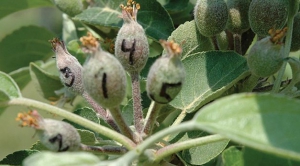
To evaluate thinning effectiveness using Duane Greene’s fruitlet model, individual apples must be labeled and measured two or three times to assess their rate of growth.
As with precision pruning, the thinning process starts by knowing how many fruit buds are on the tree and how many fruit are desired, as Steve Hoying described (see “Achieving the optimal crop load”).
Cornell University horticulturist Dr. Terence Robinson described the process growers might follow in chemical thinning.
With the variety-specific target of final fruit number per tree, a precision thinning program is conducted by applying successive thinning sprays and quickly assessing the results in time to apply subsequent thinning sprays, if needed, until the final target fruit number for each variety is achieved.
In practice, this translates into the following steps:
1. Apply a bloom thinning spray at 60 to 80 percent of full bloom.
2. Follow this with a petal fall spray two to four days after petal fall. That would be about one week after the bloom spray when fruits are 5 to 6 millimeters in diameter.
Before applying the petal fall spray, he said, the carbohydrate model that Robinson and Dr. Alan Lakso developed at Cornell should be used to guide the rate of chemical and the exact timing of the spray.
The model is at the Network for Environmental and Weather Applications at the http://NEWA.cornell.edu Web site for use by growers in New York, Massachusetts, Vermont, New Jersey, and eastern Pennsylvania. Extension educators in Michigan and Pennsylvania are also working with the carbohydrate model to make thinning decisions.
3. Assess the efficacy of the first two sprays using the fruit growth rate model developed by Dr. Duane Greene at the University of Massachusetts, which involves measuring growth of specially marked fruit. Research has shown that fruits growing at half the rate of the faster growing fruits will fall off.
4. If needed, a third spray is applied when fruit are 10 to 13 millimeters in diameter, or about one week after the petal fall spray. Again, the carbohydrate model is used as a guide to determine the rate of chemical and the exact timing of the third spray.
5. Lastly, if still more thinning is needed, a fourth spray can be applied at 16 to 20 millimeters, or about one week after the third spray, to achieve the target fruit number.
If still more thinning is needed, hand thinning is called for.

Leave A Comment